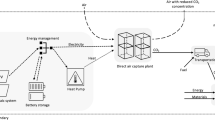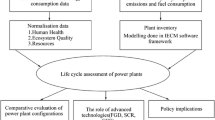Abstract
Purpose
While carbon dioxide capture and storage (CCS) has been widely recognized as a useful technology for mitigating greenhouse gas emissions, it is necessary to evaluate the environmental performance of CCS from a full life cycle perspective to comprehensively understand its environmental impacts. The primary research objective is to conduct a study on life cycle assessment of the post-combustion carbon dioxide capture process based on data from SaskPower’s electricity generation station at the Boundary Dam in Saskatchewan, Canada. A secondary objective of this study is to identify the life cycle impact assessment (LCIA) methodology which is most suitable for the assessment of carbon dioxide capture technology integrated with the power generation system in the Canadian context.
Methods
The study takes a comparative approach by including three scenarios of carbon dioxide capture at the electricity generation station: no carbon dioxide capture (“no capture”), partial capture (“retrofit”), and fully integrated carbon dioxide capture of the entire facility (“capture”). The four LCIA methods of EDIP 97, CML2001, IMPACT2002+, and TRACI are used to convert existing inventory data into environmental impacts. The LCIA results from the four methods are compared and interpreted based on midpoint categories.
Results and discussion
The LCA results showed an increase in the retrofit and capture scenarios compared to the no capture scenario in the impact categories of eutrophication air, ecotoxicity water, ecotoxicity ground surface soil, eutrophication water, human health cancer ground surface soil, human health cancer water, human health noncancer ground surface soil, ozone depletion air, human health noncancer water, and ionizing radiation. The reductions were observed in the retrofit and capture scenarios in the impact categories of acidification, human health criteria air-point source, human health noncancer air, ecotoxicity air, global warming, human health cancer air, and respiratory effects.
Conclusions
Although the four LCIA methodologies significantly differ in terms of reference substances used for individual impact categories, all (TRACI, IMPACT2002+, CML2001, and EDIP 97) showed similar results in all impact categories.






Similar content being viewed by others
Notes
Note: Constant electricity output scenario was used in the study.
References
Althaus H-J, Chudacoff M, Hellweg S, Hischier R, Jungbluth N, Osses M, Primas A (2004) Life cycle inventories of chemicals. Ecoinvent Report No. 8. Swiss Centre for Life Cycle Inventories, Dübendorf
ISO 14040 (2006) Environmental management–life cycle assessment–principles and framework. International Standard ISO 14040. Geneva: International Organization for Standardization
ISO 14044 (2006) Environmental management–life cycle assessment–requirements and guidelines. ISO 14044. Geneva: International Organization for Standardization
Koornneef J, Keulen T, Faaij A, Turkenburg W (2008) Life cycle assessment of a pulverized coal power plant with post-combustion capture, transport and storage of CO2. Int J Greenh Gas Con 2(4):448–467
Manuilova A (2011) Evaluation of environmental performance of carbon capture and storage project in Canada using life cycle assessment methodology. PhD. Thesis, University of Regina, Regina, SK
Nie Z, Korre A, Durucan S (2011) Life cycle modelling and comparative assessment of the environmental impacts of oxy-fuel and post-combustion CO2 capture, transport and injection processes. Energy Procedia 4(10):2510–2517
Pehnt M, Henkel J (2009) Life cycle assessment of carbon dioxide capture and storage from lignite power plants. Int J Greenh Gas Con 3(2):49–66
Schreiber A, Zapp P, Kuckshinrichs W (2009) Environmental assessment of German electricity generation from coal-fired power plants with amine-based carbon capture. Int J Life Cycle Assess 14(6):547–559
Singh B, Strømman AH, Hertwich EG (2011) Comparative life cycle environmental assessment of CCS technologies. Int J Greenh Gas Con 5(4):911–921
Spath P, Mann M, Kerr D (1999) Life cycle assessment of coal-fired power production. Tech. Rep. NREL/TP-570-27715, US National Renewable Energy Laboratory, Golden, CO
Suebsiri J (2010) An environmental model of carbon capture and storage with demonstration to carbon footprint and resource deletion evaluation. PhD. Thesis, University of Regina, Regina, SK
Acknowledgments
We are grateful for the financial support from the Networks of Centres of Excellence of Canada-Carbon Management Canada (CMC-NCE) to the first three authors.
Author information
Authors and Affiliations
Corresponding author
Additional information
Responsible editor: Jeroen Guinée
Electronic supplementary material
Below is the link to the electronic supplementary material.
ESM 1
(DOC 47 kb)
Rights and permissions
About this article
Cite this article
Koiwanit, J., Piewkhaow, L., Zhou, Q. et al. A life cycle assessment study of a Canadian post-combustion carbon dioxide capture process system. Int J Life Cycle Assess 19, 357–369 (2014). https://doi.org/10.1007/s11367-013-0649-2
Received:
Accepted:
Published:
Issue Date:
DOI: https://doi.org/10.1007/s11367-013-0649-2




